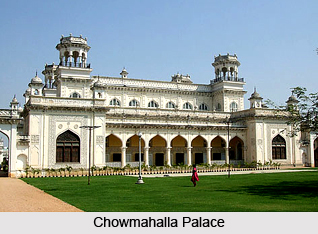 Islamic monuments in India are some of the glorious works of art in the country. As a result of successive invasions of India and the rise of Islam as a religion, several Islamic monuments like mosques, tombs, Madrasas, etc are formed. By the time the first Muslim buildings were constructed in India, the constructional principles of Islamic architecture had been well established in the great mosques of Cairo and Damascus and elsewhere in the Islamic world. However, in India the presence of a massive labour-force skilled in masonry building helped in the extensive use of stone construction rather than the plaster and rubble which was commonly used in the Middle East.
Islamic monuments in India are some of the glorious works of art in the country. As a result of successive invasions of India and the rise of Islam as a religion, several Islamic monuments like mosques, tombs, Madrasas, etc are formed. By the time the first Muslim buildings were constructed in India, the constructional principles of Islamic architecture had been well established in the great mosques of Cairo and Damascus and elsewhere in the Islamic world. However, in India the presence of a massive labour-force skilled in masonry building helped in the extensive use of stone construction rather than the plaster and rubble which was commonly used in the Middle East.
Mosques in India
The mosque or masjid, which also means the place of prostration, is the principal social, political and religious centre of Islam, intended for daily prayers, one of the five pillars of the faith. Normally, a mosque possesses a rectangular courtyard or sahn with the four sides confined by three shallow pillared cloisters and one deep portico, which acts as a covered hall of prayer and also protects the devotees from the heat of the sun. A fauwwara or fountain or tank for ritual ablutions is present there at the centre. Some of the prominent mosques in India include the Jama Masjid in Delhi. It is India`s biggest mosque and also among holds the finest works of Indian artisans. Various other mosques are Wallajah Mosque of Chennai, Atala Masjid in Jaunpur, Jumma Masjid in Bijapur, Solah Khamba Masjid in Bidar, Deval Masjid in Nizamabad, etc. Apart from mosques, tombs are also included in the list of Islamic monuments in India.
Tombs in India
A Muslim tomb where the dead are buried is also known as qabristan. It possesses a huzra or single vaulted domed chamber and at its centre is the zarih or cenotaph. Below it is the maqbara or the mortuary chamber, having a grave or qabr in the centre. The west wall, at times, bears a mihrab. Usually bigger tombs in India also have mosques attached to them as separate buildings, but the whole ensemble is within an enclosure or garden which is called a rauza. Some of the notable tombs in India include the tomb of Humayun, tomb of Akbar, tomb of Sher Shah Suri, the Paigah Tombs, etc.
Madrasas and Khanqahs
Like tombs, several other Islamic monuments in India include the Madrasas and Khanqahs. The concept of the madrasa as an institution separate from the mosque first developed in Central Asia. Basically madrasas were teaching institutions founded by strictly orthodox Sunni Muslims to fight the Shia heresy and to uphold and transmit the central traditions of the faith. But with the development of Sufism as a famous movement, organized monastic brotherhoods of mendicants; faqir in Arabic or darwish in Persian, appeared. All Sufi orders believed in the absolute importance of a pir or shaikh, a spiritual guide, who would gather about him a brotherhood. The pir`s residence was the centre of a particular order, and khanqahs or monastic mosques or retreats were constructed by endowment all over India and the Islamic world for kindred souls. Apart from these there are several other monuments built in India by the followers of Islam.
Forts in India
Islamic monuments also include the forts built by the Muslim rulers. Red Fort, the huge sandstone structure, is considered to be one of the wonderful Islamic work of art in India. The massive walls, battlements, machicolations and loopholes combined to express an overall effect of tremendous power. This combination of dynastic power and aesthetic discernment was one of the great hallmarks of Mughal Dyansty, creating monuments of unsurpassed beauty and elegance. The most ambitious architectural exercise of the reign of Akbar, and one of the most glorious examples of Indo-Islamic architecture, was the formation of an entirely new capital city at Fatehpur Sikri to commemorate the successful birth of Prince Salim, who later became Emperor Jahangir.
Palaces in India
Glorious Islamic monuments of India also include the majestic palaces built during the ancient era. The gorgeous Islamic architectural elements which structure the palaces speak of the erstwhile glory of the Muslim rulers in the bygone eras. These served as the royal residences of the rulers and till date stand as testaments of architectural marvels studded with stunning adornments and opulence. Starting from Chowmahalla Palace in Hyderabad to Jahangiri Mahal in Delhi, these palaces are scattered throughout the country. While many palaces flaunt their exclusive and magnificent Islamic architecture, some of them also exhibit exquisite blend of other architectural elements. Other prominent examples of palaces include Aga Khan Palace, Falaknuma Palace, Hill Fort Palace, Mahboob Mansion and many others.




